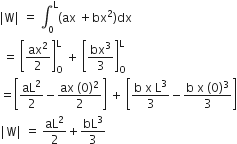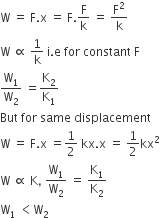When a rubber band is strecthed by a distance x, it exerts a restoring force of magnitude F = ax +bx2, where a and b are constants. The work done in stretching are unstretched rubber-band by L is
aL2 +bL2



C.



This question has statement 1 and statement 2. Of the four choices given after the statements, choose the one that best describes the two statements.
If two springs S1 and S2 of force constants k1 and k2, respectively, are stretched by the same force, it is found that more work is done on spring S1 than on spring S2.
Statement 1: If stretched by the same amount, work done on S1, will be more than that on S2
Statement 2 : k1 < k2
Statement 1 is false, Statement 2 is true
Statement 1 is true, Statement 2 is false
Statement 1 is true, Statement 2 is the correct explanation for statement 1
Statement 1 is true, Statement 2 is the correct explanation for statement 1
A.
Statement 1 is false, Statement 2 is true
As no relation between k1 and k2 is given in the question, that is why nothing can be predicted about the statement I. But as in Statment II. k1<k2
Then, for same force
An athlete in the Olympic games covers a distance of 100 m in 10 s. His kinetic energy can be estimated to be in the range
200 J − 500 J
2 × 105J − 3 × 105J
20,000 J − 50,000 J
20,000 J − 50,000 J
C.
20,000 J − 50,000 J
Approximate mass = 60 kg Approximate
velocity = 10 m/s Approximate
KE = (1/2)x60 x1000 = 3000 J
= KE range ⇒ 2000 to 5000 joule
A person trying to lose weight by burning fat lifts a mass of 10 kg upto a height of 1 m 1000 times. Assume that the potential energy lost each time he lowers the mass is dissipated. How much fat will he use up considering the work done only when the weight is lifted up ? Fat supplies 3.8×107 J of energy per kg which is converted to mechanical energy with a 20% efficiency rate. Take g=9.8 ms−2:
2.45 ×10−3 kg
6.45 x×10−3 kg
9.89 ×10−3 kg
9.89 ×10−3 kg
D.
9.89 ×10−3 kg
Given potential energy burnt by lifting weight
= mgh = 10 x 9.8 x 1 x 1000 = 9.8 x 104 J
If mass lost by a person be m, then energy dissipated
= m x 2 x 38 x 107 J /10
⇒ m = 5 x 10-3 x 9.8 / 3.8
= 12.89 x 10-3 kg
